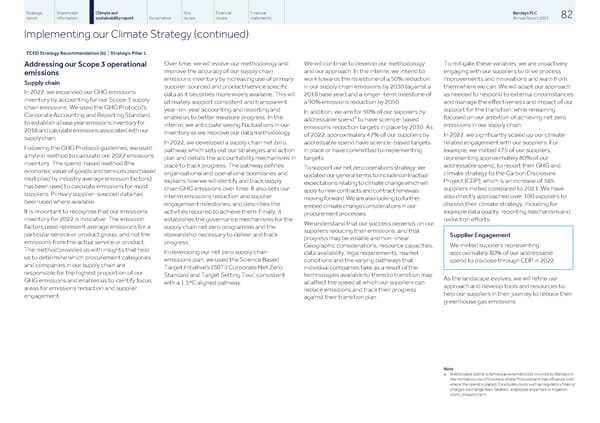Strategic Shareholder Climate and Risk Financial Financial Barclays PLC 82 report information sustainability report Governance review review statements Annual Report 2022 Implementing our Climate Strategy (continued) TCFD Strategy Recommendation (b) | Strategic Pillar 1 Over time, we will evolve our methodology and We will continue to develop our methodology To mitigate these variables, we are proactively Addressing our Scope 3 operational improve the accuracy of our supply chain and our approach. In the interim, we intend to engaging with our suppliers to drive process emissions emissions inventory by increasing use of primary, work towards the milestone of a 50% reduction improvements and innovations and learn from Supply chain supplier-sourced and product/service specific in our supply chain emissions by 2030 (against a them where we can. We will adapt our approach In 2022, we expanded our GHG emissions data as it becomes more widely available. This will 2018 base year) and a longer-term milestone of as needed to respond to external circumstances inventory by accounting for our Scope 3 supply ultimately support consistent and transparent a 90% emissions reduction by 2050. and manage the effectiveness and impact of our chain emissions. We used the GHG Protocol's year-on-year accounting and reporting and support for the transition, while remaining In addition, we aim for 90% of our suppliers by Corporate Accounting and Reporting Standard a enable us to better measure progress. In the focused on our ambition of achieving net zero addressable spend to have science-based to establish a base year emissions inventory for interim, we anticipate seeing fluctuations in our emissions in our supply chain. emissions reduction targets in place by 2030. As 2018 and calculate emissions associated with our inventory as we improve our data methodology. of 2022, approximately 47% of our suppliers by In 2022, we significantly scaled up our climate- supply chain. In 2022, we developed a supply chain net zero addressable spend have science-based targets related engagement with our suppliers. For Following the GHG Protocol guidelines, we used example, we invited 475 of our suppliers, pathway which sets out our strategies and action in place or have committed to implementing a hybrid method to calculate our 2022 emissions plan and details the accountability mechanisms in targets. representing approximately 80% of our inventory. The spend-based method (the place to track progress. The pathway defines addressable spend, to report their GHG and To support our net zero operations strategy, we economic value of goods and services purchased organisational and operational boundaries and climate strategy to the Carbon Disclosure updated our general terms to include contractual multiplied by industry average emission factors) explains how we will identify and track supply Project (CDP), which is an increase of 385 expectations relating to climate change which will has been used to calculate emissions for most suppliers invited compared to 2021. We have chain GHG emissions over time. It also sets our apply to new contracts and contract renewals suppliers. Primary supplier-sourced data has interim emissions reduction and supplier also directly approached over 100 suppliers to moving forward. We are also looking to further been used where available. engagement milestones, and describes the discuss their climate strategy, including for embed climate change considerations in our It is important to recognise that our emissions activities required to achieve them. Finally, it example data quality, reporting mechanism and procurement processes. inventory for 2022 is indicative. The emission establishes the governance mechanisms for the reduction efforts. We understand that our success depends on our factors used represent average emissions for a supply chain net zero programme and the suppliers reducing their emissions, and that particular service or product group, and not the stewardship necessary to deliver and track Supplier Engagement progress may be volatile and non-linear. emissions from the actual service or product. progress. We invited suppliers representing Geographic considerations, resource capacities, The method provides us with insights that help In developing our net zero supply chain data availability, legal requirements, market approximately 80% of our addressable us to determine which procurement categories emissions plan, we used the Science Based conditions and the varying pathways that spend to disclose through CDP in 2022. and companies in our supply chain are Target Initiative's (SBTi) Corporate Net Zero individual companies take as a result of the responsible for the highest proportion of our technologies available to them to transition may Standard and Target Setting Tool, consistent As the landscape evolves, we will refine our GHG emissions and enables us to identify focus all affect the speed at which our suppliers can with a 1.5ºC aligned pathway. approach and develop tools and resources to areas for emissions reduction and supplier reduce emissions and track their progress help our suppliers in their journey to reduce their engagement. against their transition plan. greenhouse gas emissions. Note a Addressable spend is defined as external costs incurred by Barclays in the normal course of business where Procurement has influence over where the spend is placed. It excludes costs such as regulatory fines or charges, exchange fees, taxation, employee expenses or litigation costs, property rent.
 Barclays PLC - Annual Report - 2022 Page 83 Page 85
Barclays PLC - Annual Report - 2022 Page 83 Page 85